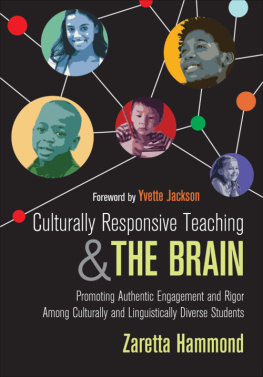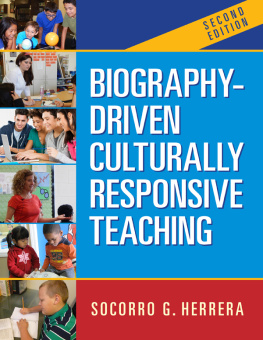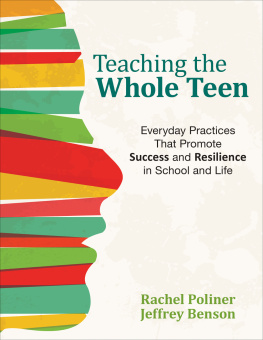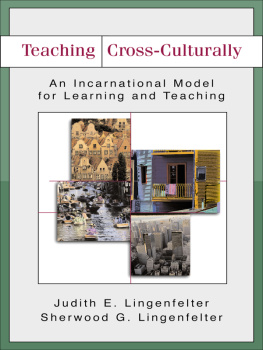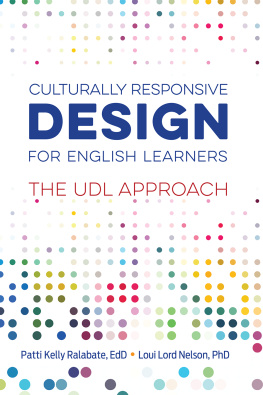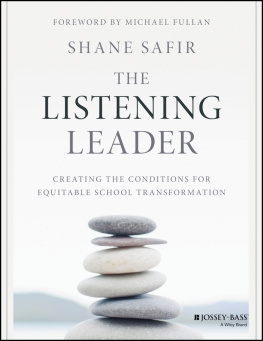Zaretta Hammond - Culturally Responsive Teaching and the Brain
Here you can read online Zaretta Hammond - Culturally Responsive Teaching and the Brain full text of the book (entire story) in english for free. Download pdf and epub, get meaning, cover and reviews about this ebook. year: 2015, publisher: SAGE Publications, genre: Religion. Description of the work, (preface) as well as reviews are available. Best literature library LitArk.com created for fans of good reading and offers a wide selection of genres:
Romance novel
Science fiction
Adventure
Detective
Science
History
Home and family
Prose
Art
Politics
Computer
Non-fiction
Religion
Business
Children
Humor
Choose a favorite category and find really read worthwhile books. Enjoy immersion in the world of imagination, feel the emotions of the characters or learn something new for yourself, make an fascinating discovery.
- Book:Culturally Responsive Teaching and the Brain
- Author:
- Publisher:SAGE Publications
- Genre:
- Year:2015
- Rating:5 / 5
- Favourites:Add to favourites
- Your mark:
- 100
- 1
- 2
- 3
- 4
- 5
Culturally Responsive Teaching and the Brain: summary, description and annotation
We offer to read an annotation, description, summary or preface (depends on what the author of the book "Culturally Responsive Teaching and the Brain" wrote himself). If you haven't found the necessary information about the book — write in the comments, we will try to find it.
Culturally Responsive Teaching and the Brain — read online for free the complete book (whole text) full work
Below is the text of the book, divided by pages. System saving the place of the last page read, allows you to conveniently read the book "Culturally Responsive Teaching and the Brain" online for free, without having to search again every time where you left off. Put a bookmark, and you can go to the page where you finished reading at any time.
Font size:
Interval:
Bookmark:


This book is dedicated to my children,
Morgan and Zindzi.
You have been my greatest teachers.

Copyright 2015 by Corwin
All rights reserved. When forms and sample documents are included, their use is authorized only by educators, local school sites, and/or noncommercial or nonprofit entities that have purchased the book. Except for that usage, no part of this book may be reproduced or utilized in any form or by any means, electronic or mechanical, including photocopying, recording, or by any information storage and retrieval system, without permission in writing from the publisher.
All trade names and trademarks recited, referenced, or reflected herein are the property of their respective owners who retain all rights thereto.
Printed in the United States of America.
ISBN 978-1-4833-0801-2
This book is printed on acid-free paper.
14 15 16 17 18 10 9 8 7 6 5 4 3 2 1

FOR INFORMATION:
Corwin
A SAGE Company
2455 Teller Road
Thousand Oaks, California 91320
(800) 233-9936
www.corwin.com
SAGE Publications Ltd.
1 Olivers Yard
55 City Road
London EC1Y 1SP
United Kingdom
SAGE Publications India Pvt. Ltd.
B 1/I 1 Mohan Cooperative Industrial Area
Mathura Road, New Delhi 110 044
India
SAGE Publications Asia-Pacific Pte. Ltd.
3 Church Street
#10-04 Samsung Hub
Singapore 049483
Acquisitions Editor: Dan Alpert
Associate Editor: Kimberly Greenberg
Editorial Assistant: Cesar Reyes
Production Editor: Amy Schroller
Copy Editor: Kimberly Hill
Typesetter: C&M Digitals (P) Ltd.
Proofreader: Laura Webb
Indexer: Karen Wiley
Cover Designer: Anupama Krishnan
Marketing Manager: Stephanie Trkay
Foreword
N euroscience research has substantiated a reality that we should relish: We are all wired for expansive learning, high intellectual performances, and self-determination!
Although this has been verified, there is a syllogism for educators that should be proven to be true and yet has still not become the performance standard: If all brains are wired for expansive learning, high intellectual performances and self-determination, then students of color should be experiencing this state of being. Since neuroscience has proven the validity of the premise of this syllogism, this is the time for a seminal question to be reckoned with: Why are so many students of color underachieving?
We cant overstate the fact that this reality is a complex conundrum, requiring the need to consider and address a myriad of underregarded factors, the most prevalent being lack of belief in the innate intellectual potential of these students. The most poignant consideration to address in order to answer this seminal question takes us back to the finding from neuroscience: If all students are wired for expansive learning and self-determination, what is needed to activate that wiring for optimal connectivity for students of color? The answer: mediating learning through cultural responsive teaching.
When the brain encounters information, especially during the act of reading and learning, its searching for and making connections to what is personally relevant and meaningful. What is relevant and meaningful to an individual is based on his or her cultural frame of reference. Finding cultural relevance and personal connections give us perspective, engages our attention, and assists us in interpreting and inferring meaning, enabling the depth of understanding and interest needed for what are considered acts of high intellectual processing such as conceptualizing, reasoning, or theorizing (Jackson, 2011).
Unfortunately, teachers are too often unaware of the fact that the connections they choose to assist students in understanding concepts being taught are in fact cultural, reflective of the lived, familiar experiences of students who are not students of color, leaving students of color in a state of disconnect, and often a deep sense of frustration. As much as they search to find the relevance that would enable them to be engaged and make meaning, they are unable, so their innate ability for high levels of cognitive processing is inhibited.
Cultural relevance is the key to enabling the cognitive processing necessary for learning and imperative for engaging and unleashing intellectual potential for students of color. Neuroscience has informed us that it is the catalyst that activates the wiring for neural connectivity to be optimized for learning. But why? And how can we use this information to assist the tens of thousands of teachers around the country who search tirelessly for whats needed to design their teaching to be culturally responsive to students of color so they can perform at the high levels they believe these students are capable of attaining?
Cultural responsiveness is not a practice; its what informs our practice so we can make better teaching choices for eliciting, engaging, motivating, supporting, and expanding the intellectual capacity of ALL our students. Culturally Responsive Teaching and The Brain: Promoting Authentic Engagement and Rigor elucidates for us the neuroscience behind why culture is the fundamental imperative for learning. Zaretta Hammond translates this science into a framework that enables teachers to both create the relationships and apply strategies that foster culturally responsive teaching to optimize learning, enabling us to make real the implication of the syllogism that students of color can demonstrate the expansive learning, high intellectual performances, and self-determination for which their brains are wired to achieve.
Dr. Yvette Jackson
Acknowledgments
I remember the day in 2000 a principal suggested I write this book as she left my conference breakout session. I had just presented findings from my 3-year pilot program on educational equity as part of the Bay Area School Reform Collaborative (BASRC) annual conference. I thought it was ironic for her to say that given so very few people had attended this session where I talked about equity, instruction, and brain science. But the idea was planted. Over the years, I found other teachers, leaders, and researchers interested in the topic. Every conversation and article shared has contributed to this book. I thank each one of you for being part of my personal learning community. I also want to thank those teachers who invited me into their classrooms to explore these ideas in real time and shared their practice with me.
I also want to appreciate my National Equity Project family. My two tours of duty allowed space to practice and refine many of these ideas. To LaShawn Route-Chatmon, I appreciate your continuous encouragement. Victor Cary, I am so glad you liked talking about neuroscience just as much as I did. And a special thank you to coaches, Mark Salinas and Colm Davis, who were so kind to read the first draft and offer insightful feedback. Its a better book because of you.
For their commitment to ensuring the next generation of teachers are culturally conscious, Id like to acknowledge my St. Marys College colleagues, Clifford Lee and Rania Leon. I am privileged to teach with you.
Next pageFont size:
Interval:
Bookmark:
Similar books «Culturally Responsive Teaching and the Brain»
Look at similar books to Culturally Responsive Teaching and the Brain. We have selected literature similar in name and meaning in the hope of providing readers with more options to find new, interesting, not yet read works.
Discussion, reviews of the book Culturally Responsive Teaching and the Brain and just readers' own opinions. Leave your comments, write what you think about the work, its meaning or the main characters. Specify what exactly you liked and what you didn't like, and why you think so.

